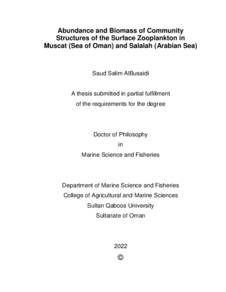وثيقة
Abundance and biomass of community structures of the surface zooplankton in Muscat (Sea of Oman) and Salalah (Arabian Sea.
عناوين أخرى
الوفرة والكتلة الحيوية لبنية مجتمع العوالق الحيوانية السطحية في مسقط (بحر عمان) وصلالة (بحر العرب)
الناشر
Sultan Qaboos University.
ميلادي
2022
اللغة
الأنجليزية
الملخص الإنجليزي
This study on surface Zooplankton examined monthly samples for two
consecutive years (2013 - 2014) collected at the sea surface from two
locations simultaneously; Muscat in the Sea of Oman and Salalah in the
Arabian Sea. The general objective was to investigate the changes in
zooplankton communities in response to the seasonal forcing of the
monsoon regime experienced differently in the Sea of Oman and the
Arabian Sea. This main goal will be achieved through the following specific
objectives: 1) Describe and characterize the zooplankton community in two
contrasting water masses, and 2) Characterize the seasonal changes in
zooplankton community structure in terms of abundances and biomass.
The species composition of the zooplankton communities varied
significantly between Salalah and the Muscat. The two communities were
most similar during winter at the time of northeast monsoon and show the
largest differences (dissimilarity) in composition during summer at the time
of southwest monsoon. The seasonal changes in community structures
were most significant for copepods and calanoid copepods and less
significant for non-copepods suggesting that the relative abundances of the
three orders of copepods (Calanoida, Cyclopoida, and Harpacticoida)
responded to the seasonal environmental changes. Out of 91 species, only
17 in Muscat and 20 in Salalah represented more than 90% of the total
zooplankton abundance. Copepods and Meroplankton had a distinct and
clear pattern in Salalah but there was no such obvious pattern in Muscat.
During periods of lack of food, certain zooplankton species, such as
Temora turbinata and Penilia avirostris in the Muscat, and Oithona spp. in
Salalah, expanded their range of feeding selection to include smaller
phytoplankton cells and ciliates through the microbial loop and, thus, defies
the concept of zooplankton paradox. No variation in the normalized
biomass spectra in both locations (-0.88 in the Muscat, and -0.87 in
Salalah). There is a seasonality in the total biomass of zooplankton in both
locations. The highest peak of biomass in both locations occurred in
southwest monsoon (Summer). However, Meroplankton showed a
seasonality in Salalah with a significant drop during southwest monsoon.
The species with the highest biomass in the Muscat seem to be adapted to
microbial loop exploitation.
المجموعة
URL المصدر
قالب العنصر
الرسائل والأطروحات الجامعية

